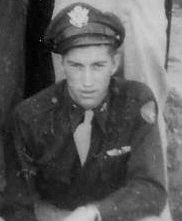Lynn Gordon Smith was born in Oklahoma on August 31, 1920. He was one of five children of Horace Edgar Smith (1 Oct 1889 28 Aug 1975), who was born at Benton, Polk County, Tennessee; and Winifred Gertrude 'Winnie' (Cornelius) Smith (23 Feb 1894 30 Jan 1995), who was born in Oklahoma. His parents married at Thomas, Custer County, Oklahoma on 22 Jul 1914. His father was a farmer, and later worked as a foreman for the Shawnee Milling Company at Shawnee, Oklahoma. By 1935 the family lived at 2610 North Park, Shawnee, Pottawatomie County, Oklahoma.
He enlisted in the U.S. Army and completed Army Air Forces pilot training. He was assigned a crew and completed B-17 operational training at Ardmore Army Air Base, Oklahoma in June 1944. The crew then traveled by train to Kearny Army Airfield, Nebraska, and was assigned a new B-17, serial number 43-38041, for the deployment to England. On July 11, 1944 the crew departed Kearny, Nebraska bound for Bangor, Maine. The flight took nine hours via the waypoints Des Moines, Iowa; Chicago, Illinois; and Buffalo, New York. On July 13 the crew flew to Gander, Newfoundland. At dusk on July 18 the crew departed Gander on the non-stop North Atlantic ferry route to the United Kingdom, and landed at Nutts Corner, near Belfast, Northern Ireland on July 19. The 2100-mile flight took 11 1/2 hours. The crew left the new B-17 at Nutts Corner, and on July 20 boarded S.S. Borinquen in Belfast Harbor. The ship sailed on July 21 and arrived at Liverpool, England on July 23. The men traveled by train to Stone, Staffordshire, England, the location of two Army Air Forces replacement control depots. They began inprocessing on July 24, and were assigned to the 837th Bomb Squadron of the 487th Bomb Group. On July 28 they traveled by train to Cockfield, Suffolk, England, and from there went by truck to their base at Army Air Forces Station 137 near Lavenham, Suffolk, England. The crew's effective date assignment was July 24, 1944. They had become part of the 8th U.S. Army Air Force in Europe.
B-17G 43-38260 crew:
Smith, Lynn G 1/Lt Pilot KIA
Huber, Charles C 2/Lt Copilot POW
Davis, Leonard C 2/Lt Navigator POW
Hubbard Jr, George D 2/Lt Bombardier POW
Evans, George D T/Sgt Engineer POW
Bachman, Harold J T/Sgt Radio Operator POW
Johnson, Warren G S/Sgt Ball Turret Gunner POW
Cummins, Fred E S/Sgt Waist Gunner POW
Bovier, Russell E S/Sgt Tail Gunner POW
On September 22, 1944 the crew took off from Lavenham in B-17G 43-38260 'Fime Sientz' on the 487th Bomb Group mission to bomb a tank factory at Kassel, Germany. It was pilot Lynn Smith's 13th combat mission. The Smith crew flew in the number 9 position of the lead Squadron. The route was planned to take the formation through a 'flak corridor' (ie: a flak-free corridor) between the known flak areas of Coblenz and Wiesbaden. However, the formation leader missed a turning point and took the formation over the Wiesbaden flak batteries. B-17 'Fime Sientz' was hit by flak over Wiesbaden, which knocked out the number 4 engine, damaged the right outboard wing, and started a fire in the wing. The bombs were salvoed, engine number 4 was feathered, and Lt Smith turned out of formation toward friendly lines. The right wing continued to burn, and Lt Smith ordered the crew to bail out. This occurred in the vicinity of Stromberg, Germany. Lt Smith was the last to exit the aircraft. He was killed in action when he landed in the Hochsteinchen Forest about five miles west-northwest of Stromberg, Germany, at approximate coordinates 49°58.6'N, 7°40'E. Navigator Leonard C. Davis wrote:
"This high hill on which we four [officers] landed was covered by a farmed woods with sections of trees in different stages of development. The pilot was unfortunate to have come down in those trees which were fully grown. They were very tall pines, having branches only at their tops with the remaining trunk bare. His death as I see it must be attributed to one of three things: (1) He delayed for some reason too long in opening his chute so that it was not fully open before striking the ground. (2) The parachute failed to open fully. (3) The parachute functioned normally but the air was spilled from it by the branches of the closely spaced trees after he had already passed through the branches and [he] had nothing more to break his fall and was not close enough to a trunk to grasp it."
The other crew members landed safely and became prisoners of war. The aircraft crashed near Seibersbach, 15 kilometers west of Bingen, Germany.
Lt Smith is buried at Ardennes American Cemetery, Neuville-en-Condroz, Belgium.
Source of information: Paul M. Webber, www.findagrave.com

